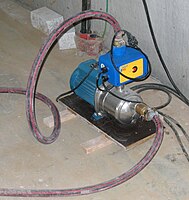
Photo from wikipedia
This paper presents direct numerical simulations of accelerated viscous flow past an infinite wedge with a focus on the effect of the accelerating rate on vortex dynamics and material transport… Click to show full abstract
This paper presents direct numerical simulations of accelerated viscous flow past an infinite wedge with a focus on the effect of the accelerating rate on vortex dynamics and material transport near the wedge tip. The wedge angle ranges π/3 ≤ βπ ≤ 5π/6 and the acceleration rate is 0 ≤ p ≤ 1. Since the wedge is infinite, the inviscid self-similar analysis predicts that the solution of one viscosity at a time is the same as the solution of a different viscosity at a scaled time. This theoretical prediction is numerically verified in the current work. Evolution of the vorticity, streamlines, and streaklines is shown in great detail. In the vorticity field, hierarchical vortex separations at the wedge tip are observed, which associate with multiple circulating regions in the streamlines. We also compare the solution at varying acceleration rates and wedge angles and explore the scaling laws in the solution. Streaklines are used to illustrate material transport in the fluid flow. The streaklines form two spirals, a major one that corresponds to the starting vortex and a second one that appears near the wedge tip. The formation of both the major and secondary spirals are investigated and diagnosed using the strain rate in the fluid flow.This paper presents direct numerical simulations of accelerated viscous flow past an infinite wedge with a focus on the effect of the accelerating rate on vortex dynamics and material transport near the wedge tip. The wedge angle ranges π/3 ≤ βπ ≤ 5π/6 and the acceleration rate is 0 ≤ p ≤ 1. Since the wedge is infinite, the inviscid self-similar analysis predicts that the solution of one viscosity at a time is the same as the solution of a different viscosity at a scaled time. This theoretical prediction is numerically verified in the current work. Evolution of the vorticity, streamlines, and streaklines is shown in great detail. In the vorticity field, hierarchical vortex separations at the wedge tip are observed, which associate with multiple circulating regions in the streamlines. We also compare the solution at varying acceleration rates and wedge angles and explore the scaling laws in the solution. Streaklines are used to illustrate material transport in the fluid flow. The streaklines form two spira...
Journal Title: Physics of Fluids
Year Published: 2020
Link to full text (if available)
Share on Social Media: Sign Up to like & get
recommendations!